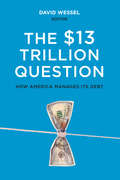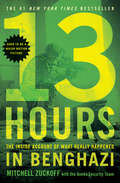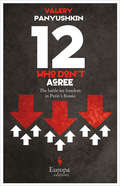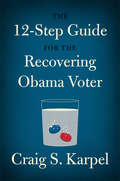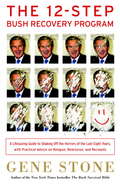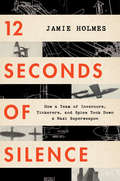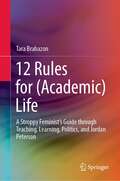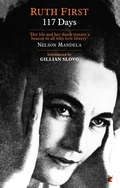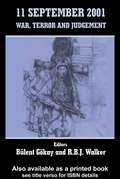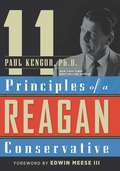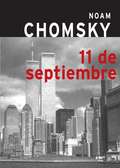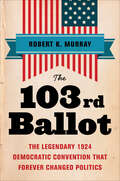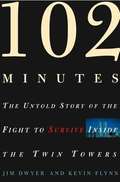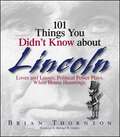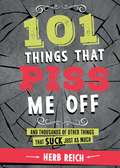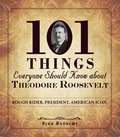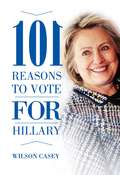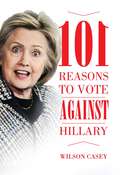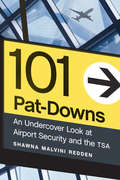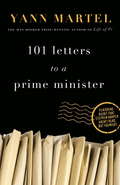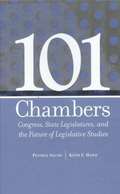- Table View
- List View
The $13 Trillion Question
by David WesselWhat is the best way for the U.S. Treasury to finance the federal government's huge debt?Everyone talks about the size of the national debt: now at $13 trillion and climbing. Few talk about how the Treasury does the borrowing, even though it is one of the world's largest borrowers. Yet everyone from bond traders to the home-buying public is affected by the Treasury's decisions about whether to borrow short or long term and what types of bonds to sell to investors.In The $13 Trillion Question, Harvard's Robin Greenwood, Sam Hanson, Joshua Rudolph, and Larry Summers argue that the Treasury could save taxpayers money and help the economy by borrowing more short term and less long term. They also argue that the Treasury and the Federal Reserve made a huge mistake in recent years by rowing in opposite directions: while the Fed was buying long-term bonds to push investors into other assets, the Treasury was doing the opposite--selling investors more long-term bonds. The Hoover Institution's John Cochrane joins the discussion by suggesting a series of new and innovative ways for Treasury to finance the debt.Each chapter of The $13 Trillion Question includes responses from a variety of public and private sector experts on how the Treasury does its borrowing. Larry Summers offers concluding comments with a call for the policy community to pay greater attention to debt management. "Debt management is too important to leave to the debt managers," he says.
The $13 Trillion Question: How America Manages its Debt
by David WesselThe underexamined art and science of managing the federal government's huge debt. Everyone talks about the size of the U. S. national debt, now at $13 trillion and climbing, but few talk about how the U. S. Treasury does the borrowing-even though it is one of the world's largest borrowers. Everyone from bond traders to the home-buying public is affected by the Treasury's decisions about whether to borrow short or long term and what types of bonds to sell to investors. What is the best way for the Treasury to finance the government's huge debt? Harvard's Robin Greenwood, Sam Hanson, Joshua Rudolph, and Larry Summers argue that the Treasury could save taxpayers money and help the economy by borrowing more short term and less long term. They also argue that the Treasury and the Federal Reservemade a huge mistake in recent years by rowing in opposite directions: while the Fed was buying long-term bonds to push investors into other assets, the Treasury was doing the opposite-selling investors more long-term bonds. This book includes responses from a variety of public and private sector experts on how the Treasury does its borrowing, some of whom have criticized the way the Treasury has been managing its borrowing.
13 Hours: The Inside Account of What Really Happened In Benghazi
by Mitchell ZuckoffThe harrowing, true account from the brave men on the ground who fought back during the Battle of Benghazi.13 Hours presents, for the first time ever, the true account of the events of September 11, 2012, when terrorists attacked the US State Department Special Mission Compound and a nearby CIA station called the Annex in Benghazi, Libya. A team of six American security operators fought to repel the attackers and protect the Americans stationed there. Those men went beyond the call of duty, performing extraordinary acts of courage and heroism, to avert tragedy on a much larger scale. This is their personal account, never before told, of what happened during the thirteen hours of that now-infamous attack.13 Hours sets the record straight on what happened during a night that has been shrouded in mystery and controversy. Written by New York Times bestselling author Mitchell Zuckoff, this riveting book takes readers into the action-packed story of heroes who laid their lives on the line for one another, for their countrymen, and for their country.13 Hours is a stunning, eye-opening, and intense book--but most importantly, it is the truth. The story of what happened to these men--and what they accomplished--is unforgettable.
12 Who Don't Agree: The Battle for Freedom in Putin's Russia
by Valery Panyushkin&“Portraits of a group of mostly young Muscovites . . . Some of [Panyushkin&’s] sketches are political fables of inspiring selflessness and courage&” (Star Tribune). In Twelve Who Don&’t Agree, journalist Valery Panyushkin profiles twelve Russians from across the country&’s social spectrum, including: a politician, a journalist, an army officer, an author, a bank manager, a laborer, and a university student. Despite varied backgrounds, they all have one thing in common: participation in 2007&’s historic March of the Dissidents. Though each of these men and women had personal reasons for joining the demonstration, they shared a belief that the government of Vladimir Putin was betraying the promise of Russia&’s future. Risking the threats and violent retaliation inflicted upon Russian journalists who dare to question the powers that be, Panyushkin boldly illuminates the lives and convictions of these twelve men and women. Their stories reveal how a growing commitment to human rights, equality, the principals of decency and fairness can transform one into a dissident in the eyes of a ruling class that does not value those same principles. And in today&’s Russia the dissidents&’ journey is one from which there is often no return. &“Panyushkin reveals a great deal about post-Soviet Russia and the kinds of constraints on freedom that most citizens still live with and try to work around. . . . [He] writes in vivid tableaux.&” —Los Angeles Times &“His compassionate yet candid outlook lends poignancy to individual portraits, with inflections of wisdom and occasional humor. Remaining defiant in the face of oppression, it is a testament to Panyushkin&’s talent that the plight of those involved is what ultimately resonates.&” —Publishers Weekly
The 12-Step Guide for the Recovering Obama Voter
by Craig S. Karpel"My name is Craig K., and I'm an Obamaholic." So begins the mock confession of a former community organizer who woke up one morning with a massive political hangover. Today, many Americans find themselves in the same uncomfortable position. Just as President Obama's uplifting words and bold promises once inspired exaggerated hopes, failed policy after failed policy have left us a nation of recovering Obamaholics. In this can't-put-it-down diatribe, award-winning journalist Craig S. Karpel alleges satirically--but proves with alarming facts--that voting for Obama was the result of a debilitating political addiction. Karpel guides us through a 12-step program for attaining "voting sobriety," and like any 12-step process, recovery begins with an admission that we have hit bottom and need to make amends. Thus we must admit to each other, and ourselves, that the Obama presidency isn't Obama's fault--it's ours. Rather than returning him to office, we the voters should be impeached for having elected him in the first place. Follow Karpel's 12-Step Guide for the Recovering Obama Voter, and get on the path to recovery--before November 6th!
The 12-Step Bush Recovery Program
by Gene Stone Carl Pritzkat Tony TravostinoThe first step is admitting that you have a Bush problem–and that you have ten bucks for this book. • Do you think that after eight years of George Bush, this country is in good shape? • Do you feel that the U. S. Constitution has too many Amendments? • Do you often dream of George Bush in a flight suit? If you answered yes to one or more of these questions, it’s time to seek help. In the tradition of the bestsellingBush Survival Bible,The 12-Step Bush Recovery Programis a lifesaving handbook that will help you recover from the Bush years. This vital guide to post-Bush era wellness features useful discussions of important issues such as Avoiding Relapse, Dealing with Embarrassment, Making Your Home a Recovery Zone, and Staging an Intervention. George W. Bush isn’t just a nuisance, he’s a problem that afflicts nearly three out of four Americans. So if you or someone you love has a Bush problem, know this: You don’t have to face it alone. Help is within reach. WithThe 12-Step Bush Recovery Program, you can share in the promise of a better you, a better America, a better world, and a better solar system. Does The 12-Step Bush Recovery Program work? Just look at these unsolicited testimonials: “The 12-Step Bush Recovery Programis the best book of its sort that I’ve ever read. ” –G. Washington, Virginia “Every American should read this book in order to understand the depth of the problem as well as the need for a new president. ” –A. Lincoln, Illinois “I liked this book, but I still don’t understand what it’s about. ” –G. W. Bush, Texas “Read this book and I will shoot you. ” –D. Cheney, Hades From the Trade Paperback edition.
12 Seconds of Silence: How a Team of Inventors, Tinkerers, and Spies Took Down a Nazi Superweapon
by Jamie HolmesThe riveting story of the American scientists, tinkerers, and nerds who solved one of the biggest puzzles of World War II—and developed one of the most powerful weapons of the war 12 Seconds of Silence is the remarkable, lost story of how a ragtag group of American scientists overcame one of the toughest problems of World War II: shooting things out of the sky. Working in a secretive organization known as Section T, a team of physicists, engineers, and everyday Joes and Janes took on a devilish challenge. To help the Allies knock airplanes out of the air, they created one of the world&’s first &“smart weapons.&” Against overwhelming odds and in a race against time, mustering every scrap of resource, ingenuity, and insight, the scientists of Section T would eventually save countless lives, rescue the city of London from the onslaught of a Nazi superweapon, and help bring about the Axis defeat. A holy grail sought after by Allied and Axis powers alike, their unlikely innovation ranks with the atomic bomb as one of the most revolutionary technologies of the Second World War. Until now, their tale was largely untold. For fans of Erik Larson and Ben Macintyre, set amidst the fog of espionage, dueling spies, and the dawn of an age when science would determine the fate of the world, 12 Seconds of Silence is a tribute to the extraordinary wartime mobilization of American science and the ultimate can-do story.
12 Rules for (Academic) Life: A Stroppy Feminist’s Guide through Teaching, Learning, Politics, and Jordan Peterson
by Tara BrabazonThese are strange times. Climate crises. Health crises. Collapsing systems. Influencers. And yes - Jordan Peterson.We are currently living in a (Post) Peterson Paradigm. This book – 12 Rules for (Academic) Life - explores what has happened to teaching, learning and politics through this odd and chaotic intervention. Deploying feminism, this lens and theory offers a glass-sharpened view of this moment in international higher education. It is organized through twelve mantras for higher education in this interregnum, and offers new, radical, edgy and passionate methodologies, epistemologies and ontologies for a University sector searching for a purpose. This is a feminist book which targets a feminist audience, both inside and outside higher education. It presents a clear focus on how this Peterson moment can be managed and challenged, when in future such academics deploy social media in this way. This book is also a part of higher education studies, exploring the role of the public / critical / dissenting / organic intellectual in debates about the political economy, identity/politics and leadership.A question of our time – through a climate emergency, a pandemic and polarized politics – is why Professor Jordan Peterson gained profile and notoriety. The Jordan Peterson moment commenced in September 2016 with his YouTube video, “Professor against political correctness,” and concluded with his debate with Slavoj Zizek on April 19, 2019. From this moment, his credibility was dented, if not destroyed.Jordan Peterson infused scholarly debates with Punch and Judy extremism and misunderstandings. Instead, this book offers research rather than certainty, interpretation rather than dogma, evidence rather than opinion, and theory rather than ‘moral truth.’ The goal is to recalibrate this (Post) Peterson Paradigm, to take stock of how this moment occurred, and how to create a revision of higher education.
117 Days: An Account of Confinement and Interrogation under the South African 90-Day Detention Law (Vmc Ser. #483)
by Ruth FirstIn prison you see only the moves of the enemy. Prison is the hardest place to fight a battle.'117 Days is Ruth First's personal account of her detention under the iniquitous '90-day' law of 1963. There was no warrant, no charge and no trial - only suspicion.This sparsely written and unique record tells of her experiences of solitary confinement, constant interrogation and instantaneous re-arrest on release - lightened by humorous portraits of governors, matrons, wardresses and interrogators, seen as the tools of the police state.
117 Days: An Account of Confinement and Interrogation under the South African 90-Day Detention Law (Virago Modern Classics #139)
by Ruth FirstIn prison you see only the moves of the enemy. Prison is the hardest place to fight a battle.'117 Days is Ruth First's personal account of her detention under the iniquitous '90-day' law of 1963. There was no warrant, no charge and no trial - only suspicion.This sparsely written and unique record tells of her experiences of solitary confinement, constant interrogation and instantaneous re-arrest on release - lightened by humorous portraits of governors, matrons, wardresses and interrogators, seen as the tools of the police state.
11 September 2001: War, Terror and Judgement
by Bülent Gökay R.b.j.walkerIn a comprehensive study of the world since September 11th, 2001, the contributors to this volume offer a series of perspectives on current security trends. The scholars who participated in this study are from Europe, North America and Asia.
11 Principles of a Reagan Conservative
by Paul KengorPerhaps no other president's name is invoked by politicians as much as Ronald Reagan's. Every election, as presidential hopefuls jockey for the Republican nomination, each one claims to be a Reagan conservative. But are these candidates truly carrying on the mantle of Ronald Reagan, or are they abusing the memory of our great president? What did Ronald Reagan really believe? In 11 Principles of a Reagan Conservative, biographer Paul Kengor analyzes Ronald Reagan's speeches and actions to paint a full, accurate picture of his beliefs. Kengor identifies these principles that lie at the crux of Reagan's conservatism; Freedom, Faith, Family, Sanctity and Dignity of Human Life, American Exceptionalism, The Founders' Wisdom and Vision, Lower Taxes, Limited Government, Peace Through Strength, Anti-Communism, and Belief in the Individual. And it is through these principles that Reagan's modern emulators may create a successful, conservative future.Many a politician has asked: What would Reagan do if he were president now? Where would Reagan stand on today's issues? Who is the next Ronald Reagan? Paul Kengor dissects Reagan's presidency and provides decisive conclusions. The answers to some of these questions may surprise conservatives and liberals alike.
11 de Septiembre (Open Media Series)
by Noam ChomskyEn 11 de septiembre Noam Chomsky disecciona las causas de raíz de la catástrofe del 11 de septiembre, sus precedentes históricos, y las posibles consecuencias mientras el mundo se mueve hacia la realidad de después del 11 de septiembre.
The 103rd Ballot: The Legendary 1924 Democratic Convention That Forever Changed Politics
by Robert Keith MurrayA fascinating political narrative, analyzing the chaotic1924 Democratic Convention that left the Democratic Party divided for years in its wake—with striking parallels to this summer's upcoming Democratic Convention, which will determine the Democratic candidate for the 2016 election for president of the United States.Divided over the contentious issues of Prohibition and the Ku Klux Klan, a fractured Democratic Party met in the summer of 1924 to elect a presidential nominee. With drastically opposing views between front-runners William Gibbs McAdoo of California and Governor Al Smith of New York, and the "favorite sons"—candidates running without national support—rigid division amongst the party led to the need for a 103rd ballot. Robert Keith Murray expertly captures the upheaval of the convention and the detrimental impact it had on the party long after a candidate had been officially selected. This riveting narrative and exceptional analysis provides a captivating look on one of the most controversial presidential conventions in American history, one that will highly resonate with readers given the state of political dissonance today.
102 Minutes: The Untold Story of the Fight to Survive Inside the Twin Towers
by Jim Dwyer Kevin FlynnAt 8:46 am on September 11, 2001, 14,000 people were inside the twin towers-reading e-mails, making trades, eating croissants at Windows on the World. Over the next 102 minutes, each would become part of a drama for the ages, one witnessed only by the people who lived it-until now. <P><P> Of the millions of words written about this wrenching day, most were told from the outside looking in. New York Times reporters Jim Dwyer and Kevin Flynn have taken the opposite-and far more revealing-approach. Reported from the perspectives of those inside the towers, 102 Minutes captures the little-known stories of ordinary people who took extraordinary steps to save themselves and others. Beyond this stirring panorama stands investigative reporting of the first rank. An astounding number of people actually survived the plane impacts but were unable to escape, and the authors raise hard questions about building safety and tragic flaws in New York's emergency preparedness. <P><P> Dwyer and Flynn rely on hundreds of interviews with rescuers, thousands of pages of oral histories, and countless phone, e-mail, and emergency radio transcripts. They cross a bridge of voices to go inside the infernos, seeing cataclysm and heroism, one person at a time, to tell the affecting, authoritative saga of the men and women-the nearly 12,000 who escaped and the 2,749 who perished-as they made 102 minutes count as never before. 102 Minutes is a 2005 National Book Award Finalist for Nonfiction.
101 Things You Didn't Know About Lincoln: Loves And Losses! Political Power Plays! White House Hauntings!
by Brian ThorntonDiscover the man behind the myth.One hundred fifty years after his death, Abraham Lincoln remains one of America's most fascinating, brilliant, and visionary leaders. He's idolized as a hero, a legend, and even a secular saint. But what about the real man behind the stone monument?In this engaging, intelligent book, you'll learn about more than just his savvy political skills and Civil War power plays. 101 Things You Didn't Know about Lincoln reveals other little known details of his personal and professional life, including:How Lincoln escaped death more than once as a childWhy he once used a chicken bone to argue a court caseWhy the Lincolns kept goats at the White HouseWhen and why he grew that beardHow John Wilkes Booth's brother saved Lincoln's sonWho tried to rob Lincoln's graveFilled with these and other offbeat facts, 101 Things You Didn't Know about Lincoln is sure to fascinate, whether you're a newcomer to Lincoln legend and lore, or a hardcore history buff!
101 Things That Piss Me Off: And Thousands of Other Things That Suck Just As Much
by Herb W. ReichComplaining, psychologists assert, is good for your health. It acts as a relief valve to help dispel the pent up energy generated by our daily frustrations, personal peeves, and life-long vexations. Now curmudgeons, gripers, grousers, and complainers have their own place to discard their tension! 101 Things That Piss Me Off is the manifesto guaranteed to help even the crabbiest soul let loose. Here is just a sample list of items guaranteed to piss anyone off:•Aggressive drivers who give the finger•People who graduated from assertiveness courses•Elevator music•Having the best senators money can buy•Appliances that fail the day after the warranty expires•Nineteen-year-old tech millionaires•People who are more inept than we give them credit for
101 Things I Learned® in Urban Design School (101 Things I Learned)
by Matthew Frederick Vikas MehtaProviding unique, accessible lessons on urban design, this title in the bestselling 101 Things I Learned® series is a perfect resource for students, recent graduates, general readers, and even seasoned professionals. Students of urban design often find themselves lost between books that are either highly academic or overly formulaic, leaving them with few tangible tools to use in their design projects. 101 Things I Learned® in Urban Design School fills this void with provocative, practical lessons on urban space, street types, pedestrian experience, managing the design process, the psychological, social, cultural, and economic ramifications of physical design decisions, and more. Written by two experienced practitioners and instructors, this informative book will appeal not only to students, but to seasoned professionals, planners, city administrators, and ordinary citizens who wish to better understand their built world.
101 Things Everyone Should Know about Theodore Roosevelt
by Sean AndrewsThe inside story of Teddy's life and presidency! You probably know that Theodore Roosevelt was the 26th president of the United States, but did you also know that he suffered great bouts of homesickness? Or that he carried a vial of morphine at all times in case he ever needed to take his own life? Though the image of President Theodore Roosevelt is one of fringed suede jackets and wire circles of glass framing a serious and scowling face, the man behind this image was a spectacularly intelligent and complex individual. 101 Things Everyone Should Know about Theodore Roosevelt explores the nuances of his famous life, giving little-known facts that complete the picture of Theodore Roosevelt. From his crippling childhood to his involvement with the Rough Riders, this book celebrates the American icon whose beliefs are still riveting almost 100 years after his death.
101 Things Everyone Should Know about Theodore Roosevelt: Rough Rider. President. American Icon.
by Sean AndrewsThe inside story of Teddy's life and presidency!You probably know that Theodore Roosevelt was the 26th president of the United States, but did you also know that he suffered great bouts of homesickness? Or that he carried a vial of morphine at all times in case he ever needed to take his own life?Though the image of President Theodore Roosevelt is one of fringed suede jackets and wire circles of glass framing a serious and scowling face, the man behind this image was a spectacularly intelligent and complex individual. 101 Things Everyone Should Know about Theodore Roosevelt explores the nuances of his famous life, giving little-known facts that complete the picture of Theodore Roosevelt. From his crippling childhood to his involvement with the Rough Riders, this book celebrates the American icon whose beliefs are still riveting almost 100 years after his death.
101 Reasons to Vote for Hillary
by Wilson Casey101 REASONS TO VOTE FOR HILLARY CLINTONAs the 2016 elections approach, Hillary Clinton’s presidential candidacy is one of the hottest topics among voters and the media. Clinton has worn many hats in congress and is a well-respected leader--voters consider her one of the best female candidates for the president’s seat in history. She does not succumb to pressure and has the experience this country has been longing for. 101 Reasons to Vote for Hillary Clinton will help readers understand why Clinton’s backbone and relationship with America make her a perfect presidential candidate including:The US would have its First Female President.Clinton supports policies implemented by the previous administration like Affordable Care Act.She is a highly experienced: a former Senator, Secretary of State, and First Lady.Clinton is pro-choice and pro-environment.101 Reasons to Vote for Hillary Clinton will make decision-making at the 2016 elections easy and meaningful.101 REASONS TO VOTE AGAINST HILLARY CLINTONHillary Clinton’s presidential candidacy is one of the most talked about issues of the 2016 elections. As a former Senator, First Lady, and Secretary of State, she continues to be a controversial figure and is larger known as someone who will lead the country with a backhanded agenda of "my way or no way.” 101 Reasons Not to Vote for Hillary Clinton will help readers understand why Clinton’s uncompromising character and experience do not make her a strong presidential candidate, such as:Americans don’t need another Clinton in the White House after the Bill Clinton scandal.Simply put, she seems "cold”.Clinton voted for the war in Iraq.She was once a republican, now she’s a democrat who is considered a centrist by members of her own party.And much more.101 Reasons Not to Vote for Hillary Clinton will bring a fresh and concise perspective on Clinton’s candidacy during the elections.
101 Reasons to Vote against Hillary
by Wilson Casey101 REASONS TO VOTE AGAINST HILLARY CLINTONHillary Clinton’s presidential candidacy is one of the most talked about issues of the 2016 elections. As a former Senator, First Lady, and Secretary of State, she continues to be a controversial figure and is larger known as someone who will lead the country with a backhanded agenda of "my way or no way.” 101 Reasons Not to Vote for Hillary Clinton will help readers understand why Clinton’s uncompromising character and experience do not make her a strong presidential candidate, such as:Americans don’t need another Clinton in the White House after the Bill Clinton scandal.Simply put, she seems "cold”.Clinton voted for the war in Iraq.She was once a republican, now she’s a democrat who is considered a centrist by members of her own party.And much more.101 Reasons Not to Vote for Hillary Clinton will bring a fresh and concise perspective on Clinton’s candidacy during the elections.
101 Pat-Downs: An Undercover Look at Airport Security and the TSA
by Shawna Malvini ReddenTwo million people fly commercially every day in the United States, and every single passenger must interact with members of airport security. Why do travelers put up with long lines and invasive screenings? Why do Transportation Security Administration officers (TSOs) put up with the disrespect and anger directed at them? Shawna Malvini Redden asked these questions for years—interviewing passenger and security officers alike, taking note of everything from carry-on bananas to passengers who fumed when their water bottles were confiscated. Malvini Redden encountered a range of passengers: the entitled business travelers; the parents with toddlers; the hot mess, travels-once-a-year, can&’t-figure-out-how-to-get-through-the-security-checkpoint-without-crying flier. The answers, Malvini Redden admitted, were far more complex than she anticipated.101 Pat-Downs is the story of Malvini Redden&’s research journey, part confessional, part investigative research, and part light-hearted social commentary. In it she illuminates common experiences in airport security checkpoints specifically focused on emotion and identity, presenting the inside scoop on airport security interactions via her experiences and those of passengers and TSOs. Along the way Malvini Redden introduces common characters of airport security, humanizing the stereotypically gruff TSO and explaining in a social-science framework why so many passengers feel nervous inside TSA checkpoints. Ultimately, Malvini Redden shows how people navigate communication in complex interpersonal situations and offers research-driven suggestions for improving interactions for passengers and TSOs alike.
101 Letters to a Prime Minister
by Yann MartelFrom the mailbox of the Prime Minister's Office to your bookshelf, a list of more than 100 books that every Canadian should read. This largely one-sided correspondence from the "loneliest book club in the world" is a compendium for bibliophiles and those who follow the Canadian political scene. Smart, subversive, signed, sealed, and now available to you...even if your address is not 80 Wellington Street.
101 Chambers: Congress, State Legislatures, and the Future of Legislative Studies
by Peverill Squire Keith E. HammThe book compares and contrasts Congress and the state legislatures on histories, fundamental structures, institutional and organizational characteristics, and members. By highlighting the vast array of organizational schemes and behavioral patterns evidenced in state legislatures, the authors demonstrate that the potential for the study of American legislatures, as opposed to the separate efforts of Congressional and state legislative scholars, is too great to leave unexplored.
